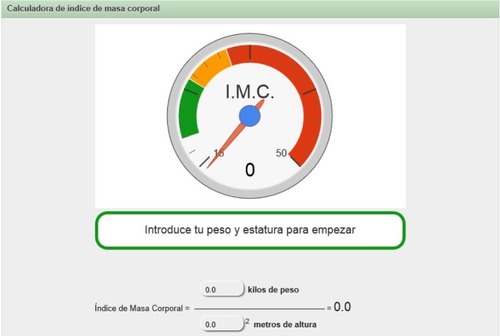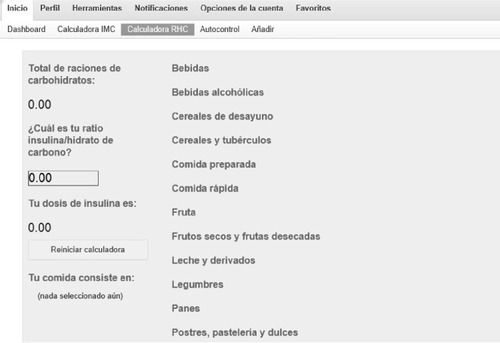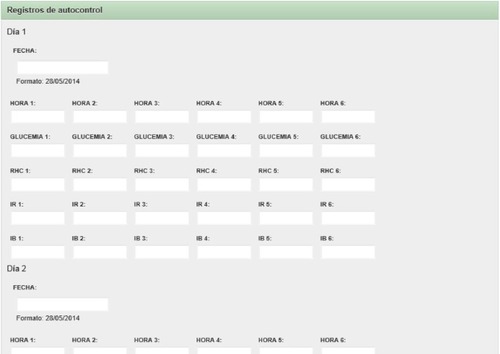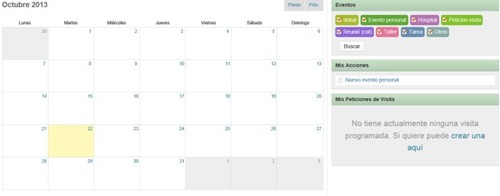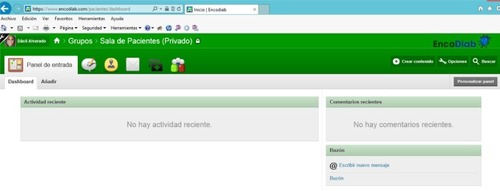Abstract
Purpose
The purpose of this study was to develop, build, and implement a virtual platform equipped with practical tools, relevant contents, and communication rooms, with the aim of facilitating patients’ self-management of type 1 diabetes mellitus (T1DM).
Materials and methods
The design of the platform was based on the suggestions of T1DM patients who were being managed at two reference hospitals. Patients’ needs and preferences were identified in group discussion sessions. Before having access to the platform, patients underwent a baseline assessment, which included physical examination and the administration of validated questionnaires for evaluation of clinical background, quality of life, treatment satisfaction, and well-being.
Results
A total of 33 patients were included in the study; 54.5% of them were men, their median age was 34 (18–50) years, the median duration of diabetes was 15 (1–38) years, and the median A1C was 7.4% (6%–12.6%). Based on their suggestions and requests, the online platform EncoDiab was built and organized into four domains: a personal domain, two domains shared by the patients and the staff of each of the two participating hospitals, and one domain that was accessible to all participants. The platform included practical tools (a body mass index calculator, a carbohydrate counting tool, and an insulin-dose calculator), a library with relevant information (documents on prevention and treatment of acute complications, nutrition, exercise, etc), and a chat room.
Conclusion
Although the study is still ongoing, our current results demonstrate the feasibility of building and implementing an online platform for helping T1DM patients in the self-management of their disease in the public health setting.
Introduction
Tight glycemic control in type 1 diabetes mellitus (T1DM) reduces the risk of developing chronic complications of the disease.Citation1 However, barriers preventing glycemic improvement can be found in the patient, in health care professionals, in the disease itself, and in the organization of health care services.Citation2,Citation3 Indeed, the daily management of the disease usually falls on the patient. Although providing an environment that facilitates diabetes self-management and allows for informed decision making is a challenge, it may contribute to improve the management of T1DM.Citation4
Comanagement of this disease has already proved feasible.Citation5,Citation6 The aim of the present project was to shift the task of disease management and responsibility from health care professionals to patients themselves by providing high-quality resources to support them in self-management and informed decision making.
The incorporation of the Internet into our daily life has transformed the relationship between patients and health care professionals.Citation7 Nowadays, “the web” is the most frequently consulted source of information on diseases. Nevertheless, the reliability of certain content is uncertain, and myths and lies are also spread efficiently.Citation7 In the context of a reliable virtual environment, accurate information can be a powerful tool to support patients’ self-management of this disease, without the time and space limits of other resources.
New technologies can be used by health care professionals to assist patients in the management of diabetes. Actually, randomized controlled trials have shown that web-based support may have a positive impact on the process and quality of diabetes care, quality of life, and treatment satisfaction.Citation8–Citation10 Virtual interaction among patients with the same disease has not been rigorously assessed, but reports on discussion groups, chats, or a combination of these with news groups have been published.Citation11 Most of them are run and promoted by health professionals, who stimulate discussion, propose or answer questions, or post useful pieces of news. A study analyzing patients’ perspectives highlighted the importance given to peer support, their awareness of the need to evaluate external information in each patient’s own context, and the value given to the experiential knowledge of other people with the same disease.Citation12
The goal of this study was to design, build, and implement a virtual management system for patients with T1DM, in the public health care setting. It was conceived as a structure integrating information, education, assistance, and socialization. It followed the principles of the Web 2.0 philosophy, which enhances bidirectional communication and promotes adaptation of technological tools to the needs and skills of potential users. In the present article, we describe the design and implementation processes, as well as the baseline characteristics of the patients included in this study. The outcome of the use of the platform will be reported in the future.
Materials and methods
Study population and design
Participants were recruited among T1DM patients who were being treated at any of the two participating hospitals (Complejo Hospitalari Universitario Insular Materno-Infantil of Gran Canaria, Las Palmas, Spain and Hospital Universitari Arnau de Vilanova in Lleida, Spain). Inclusion criteria were: patients older than 18 years, T1DM diagnosed at least 1 year before, Internet connection at home, basic skills in the use of information and communications technology, and having an email account. Pregnant women and people with psychiatric or other conditions that could potentially interfere with follow-up were excluded. The study was approved by the Ethics Committees of both participating hospitals. Patients were contacted in the outpatient clinic, where they were offered a brief description of the study and invited to participate. Interested patients were appointed for a subsequent specific visit, where they were given detailed oral and written information and those wanting to participate were asked to sign an informed consent form. They were also asked to sign consent for potential promotional use of the pictures taken during the group sessions. Furthermore, the participants committed themselves to honor privacy and to act with mutual respect in the interactions within the platform.
In order to identify the patients’ needs and preferences, group sessions were organized, where participants were asked about the tools and contents they would like to find on an online platform. Indeed, one of the main goals of this project was that the patients themselves settled the basis for the design of the platform.
The 17 participants from the Complejo Hospitalario Universitario Insular Materno-Infantil of Gran Canaria were split into two groups, which took part in two parallel 2-hour group discussion sessions. Brainstorming was used to identify and record all the relevant aspects suggested by the participants,Citation13 which were then ordered by priority (since it was assumed that covering all the recorded items within this project would not be feasible).
Participants from the Hospital Universitario Arnau de Vilanova in Lleida participated in 2-hour discussion sessions in two groups of eight subjects each. They were asked to discuss those aspects that would improve their quality of life and diabetes management. A sociology PhD student, who was in charge of designing the virtual environment, a diabetes nurse specialist (from the Lleida Patients Association), and the engineer in charge of the final platform design were present in the sessions and provided advice when needed.
Patients’ needs and suggestions identified in both hospitals were compiled into a common document, which was used as the basis for the design of the platform. The platform was built by using the content management system Drupal and adapted to the requirements of this type of system, as well as to those established by the patients. It was hosted on an independent dedicated server in compliance with the national regulations (law LO 15/1999 on the protection of personal data [LOPD] and RD 1720/2007, BOE-A-2008-979).
Patients
The initial population of the study included 33 patients (17 from Gran Canaria and 16 from Lleida): 54.5% of them were men; the median age was 34 (18–50) years; they had a median T1DM duration of 15 (1–38) years, a median A1C of 7.4% (6%–12.6%), and a median body mass index (BMI) of 24.6 (16.4–37.7 kg/m2); and 72.7% of them were workers, 24.2% were students, and 3% were homemakers. shows their needs and suggestions as recorded during the group sessions.
Table 1 Patient requests for EncoDiab
Implementation and evaluation
Six months after the initial group sessions, patients were appointed for a baseline evaluation visit, before being given access to the platform. Every participant received an email with their individual username and password to access the platform. There, they would find the contents and tools they had previously suggested and would be able to communicate with other participants and with health care professionals at their hospital.
During the baseline evaluation visit, information was collected on diabetes, possible associated complications, cardiovascular risk factors, and other possible diseases and treatments. Physical examination included blood pressure, anthropometric measurements, and foot examination. Blood samples were collected to measure A1C (high-performance liquid chromatography-National Glycohemoglobin Stan-dardization Program standardized), lipids, kidney and liver assessment (colorimetry), thyroid-stimulating hormone (TSH), and albuminuria.
To evaluate quality of life and treatment satisfaction, the validated, Spanish versions of the following questionnaires were administered: Audit of Diabetes-Dependent Quality of Life,Citation14 Diabetes Treatment Satisfaction Questionnaire,Citation15 and 12-item Well-Being Questionnaire.Citation16 In addition, each patient was asked to define up to three personal goals related to the platform, to be assessed during the follow-up.
All of these parameters were evaluated at baseline and again 12 months later. In addition, participants’ activity, use of resources, and permanence on the platform during the 6 months following their first access were quantified by using tools incorporated into the platform.
The platform EncoDiab was built progressively and did not include all of the patients’ suggestions from the start. At present, it is organized into four domains: a personal domain for every participant, one for interactions between the patients and health care professionals in Lleida, one for interactions between the patients and health care professionals in Gran Canaria, and one for general interactions among all participants.
Personal domains include: a customizable entry panel for profile editing, access to interactive tools (BMI calculator, glucose and insulin-dose register, carbohydrate portion calculator, and insulin-dose calculator), and activation of subscriptions to notifications. shows the BMI calculator, a simple tool in which patients can enter their weight and height and get their BMI as a result. A color code shows whether the BMI is healthy or not (green for normal, yellow for overweight, and red for obesity). shows the carbohydrate portion and insulin-dose calculator and shows the glucose and insulin-dose register, which can be submitted to a health care professional for evaluation. In addition, this domain includes an internal mail system for private one-to-one communication, a personal calendar (), and access to other areas the participant is allowed to enter.
The other domains are structured as follows: a customizable entry panel, a blog, a group calendar, a list of members allowed interaction in the domain, and a chat room. The library () contains a folder with recent commented articles, a section about physical exercise (how to start an exercise program, recommendations for insulin-dose adjustments, etc), a folder with legal information (subsidies), a folder with relevant health information (glucose meters, continuous glucose sensors, management of hypoglycemia and ketosis), a folder with documents on nutrition (general recommendations, links, food groups, healthy eating, frequently asked questions, recipes), selected links, and video tutorials about the use of the platform.
Figure 5 Access to the library.

There is also a discussion section, which was created with the aim of facilitating interaction among patients ().
Validation group
Upon continuation of the project, 6 months after the start of the use of the platform, a new group of 29 patients (who did not participate in the design) has been given access to it after a baseline evaluation equivalent to that of the first group. This second group will be followed for 1 year. The details and results of this validation process will be published in the future.
Amplification of EncoDiab
A few months after the validation group was given access to the platform, it was also opened to other adults with T1DM who were interested. At the time of the present report, a total of 175 users are members of EncoDiab. An online questionnaire will be used to evaluate their satisfaction with the platform.
Discussion
T1DM has a huge impact on the lives of people who have the disease. Strategies aimed at empowering patients to manage it independently have proved to be effective.Citation4 EncoDiab offers the tools for establishing a virtual community that facilitates communication among patients and with health care professionals. It provides practical tools for daily diabetes management and reliable information to support informed decision making. Above all, it is conceived as a place where patients play the leading role. This type of platform may offer other benefits, such as reducing isolation, promoting a positive psychological state, and acquiring healthy habits.Citation17 Studies have shown that discussion forums and conversation rooms for interaction among patients who suffer from the same disease may have a positive effect on the participants, leading them to a more favorable disposition to control their disease.Citation18 The availability of a reliable setting, with health professionals who offer advice and select and provide appropriate information, may empower patients to take responsibility for the control of their disease, have a positive effect on their level of commitment, and help them establish actions leading to better diabetes care.Citation19 Other authors have reported the benefits of online platforms like EncoDiab, such as helping reduce communication barriers between patients and health care providers,Citation20 which may eventually lead to improved self-care and self-management of disease.Citation21 EncoDiab also facilitates peer support. Indeed, several studies have illustrated the importance of patient–health care provider communicationCitation22,Citation23 and peer support in diabetes care.Citation24
Previous studies on the effects of mobile tools, including web pages – which promote self-management and communication with health professionals – on T1DM patients, reported either improved glycemic controlCitation25 or no additional benefit when compared with conventional treatment.Citation26,Citation27
The development of EncoDiab was based on the participation of patients from the start, which is, in our opinion, the best way to design a system for such a close collaboration between providers and users. The early involvement of the users, even in the design of the platform, does not guarantee its success, but it should improve the odds. Indeed, the requests made by the participants in both centers (located in different and distant regions) were quite similar. Therefore, it is expected that the design of the platform would also meet the needs of other users. Although the analysis of the results is still in progress, the evaluation of the platform by its current users (more than 150) – only a minority being present from the start – is expected to provide further information about its generalizability.
Conclusion
The use of online resources for the self-management of health conditions is a necessity in communication and technology information society. Actually, self-management is being increasingly demanded by patients, and the public health system is expected to provide solutions. In T1DM in particular, self-care is a pivotal element, which could allow patients to live with high levels of independence from the health care team. To our knowledge, there is no previous evidence in our health care system on the feasibility, efficacy, or impact of a patient-centered, patient-designed online system like EncoDiab, which allows for comprehensive self-management of T1DM.
EncoDiab makes use of technology to complement standard diabetes education. Patients are provided with reliable online resources that can be accessed anytime from anywhere.
Since the study is ongoing, the analysis of the outcomes is still incomplete. The goal of this project was not focused on demonstrating the effectiveness of a telemedicine system, but on building, implementing, and evaluating a T1DM self-management system, based on patients’ requirements, in a real-world, public health care setting. Conclusions would be premature at this point. However, in case the goal of this project is finally achieved, it could lead not only to further optimization of T1DM self-management, but also to its possible application to other populations (pregnant women, children, and adolescents) or types of diabetes, especially the highly prevalent type 2 diabetes.
Acknowledgments
Dácil Alvarado-Martel is funded by a predoctoral fellowship (Agencia Canaria de Investigación, Innovación y Sociedad de la Información TESIS20120050). Nuria Alcubierre holds a predoctoral fellowship from Instituto de Salud Carlos III, FI11/0008. During the study, the authors received grants from the European Foundation for the Study of Diabetes (EFSD/JDRF/Novo Nordisk 2008 Programme for type 1 Diabetes) (AMW, JN) and the Instituto de Salud Carlos III (PI06/1104 [DM]; PI08/01113 [JN, AMW]; PI10/02310 [DAM, RV, AC, MHG, DM, AMW]; and PI11/02441 [AMW]).
Disclosure
The authors report no conflicts of interest in this work.
References
- No authors listedThe effect of intensive treatment of diabetes on the development and progression of long-term complications in insulin-dependent diabetes mellitus. The Diabetes Control and Complications Trial Research GroupN Engl J Med19933299779868366922
- ValenzuelaJMSeidMWaitzfelderBSEARCH for Diabetes in Youth Study GroupPrevalence of and disparities in barriers to care experienced by youth with type 1 diabetesJ Pediatr20141641369137524582008
- WilkinsonAWhiteheadLRitchieLFactors influencing the ability to self-manage diabetes for adults living with type 1 or 2 diabetesInt J Nurs Stud20145111112223473390
- FunnellMMAndersonRMWorking toward the next generation of diabetes self-management educationAm J Prev Med2002223511985929
- GoldbergHIRalstonJDHirschIBHoathJIAhmedKIUsing an Internet comanagement module to improve the quality of chronic disease careJt Comm J Qual Saf20032944345114513667
- JenningsAPowellJArmstrongNSturtJDaleJA virtual clinic for diabetes self-management: pilot studyJ Med Internet Res200911e1021821504
- HartzbandPGroopmanJUntangling the Web – patients, doctors, and the InternetN Engl J Med20103621063106620335581
- HolbrookAThabaneLKeshavjeeKCOMPETE II InvestigatorsIndividualized electronic decision support and reminders to improve diabetes care in the community: COMPETE II randomized trialCMAJ2009181374419581618
- McCarrierKPRalstonJDHirschIBWeb-based collaborative care for type 1 diabetes: a pilot randomized trialDiabetes Technol Ther20091121121719344195
- MulvaneySARothmanRLWallstonKALybargerCDietrichMSAn internet-based program to improve self-management in adolescents with type 1 diabetesDiabetes Care20103360260420032275
- EysenbachGPowellJEnglesakisMRizoCSternAHealth related virtual communities and electronic support groups: systematic review of the effects of online peer to peer interactionsBMJ2004328116615142921
- ArmstrongNPowellJPatient perspectives on health advice posted on Internet discussion boards: a qualitative studyHealth Expect20091231332019555377
- OsbornAFApplied Imagination: Principles and Procedures of Creative Thinking3rd revised edCharles Scribner’s Sons1979
- BradleyCToddCGortonTSymondsEMartinAPlowrightRThe development of an individualized questionnaire measure of perceived impact of diabetes on quality of life: the ADDQoLQual Life Res19988799110457741
- BradleyCDiabetes Treatment Satisfaction Questionnaire (DTSQ)Handbook of Psychology and Diabetes: A Guide to Psychological Measurement in Diabetes Research and PracticeSwitzerlandHarwood Academic Publishers1994111132
- McMillanCVBradleyCGibneyJRussell-JonesDLSönksenPHPsychometric properties of two measures of psychological well-being in adult growth hormone deficiencyHealth Qual Life Outcomes200641616553952
- DennisCLPeer support within a health care context: a concept analysisInt J Nurs Stud20034032133212605954
- ZrebiecJFJacobsonAMWhat attracts patients with diabetes to an internet support group? A 21-month longitudinal website studyDiabet Med20011815415811251681
- BanduraASelf-efficacy: toward a unifying theory of behavioral changePsychol Rev197784191215847061
- BundesmannRKaplowitzSAProvider communication and patient participation in diabetes self-carePatient Educ Couns20118514314721035296
- ShawRJFerrantiJPatient-provider internet portals – patient outcomes and useComput Inform Nurs20112971472021697705
- GreyMWhittemoreRJeonSMurphyKFaulknerMSDelamaterATeenCope Study GroupInternet psycho-education programs improve outcomes in youth with type 1 diabetesDiabetes Care2013362475248223579179
- NicholasDBGutwinCPatersonBExamining preferences for website support to parents of adolescents with diabetesSoc Work Health Care20135286287924117033
- DonkinLChristensenHNaismithSLNealBHickieIBGlozierNA systematic review of the impact of adherence on the effectiveness of e-therapiesJ Med Internet Res201113e5221821503
- PetersonAImproving type 1 diabetes management with mobile tools: a systematic reviewJ Diabetes Sci Technol20148485986424876414
- EsmatjesEJansàMRocaDTelemed-Diabetes GroupThe efficiency of telemedicine to optimize metabolic control in patients with type 1 diabetes mellitus: Telemed studyDiabetes Technol Ther20141643544124528195
- SuhSJeanCKooMA randomized controlled trial of an internet-based mentoring program for type 1 diabetes patients with inadequate glycemic controlDiabetes Metab J20143813414224851207

